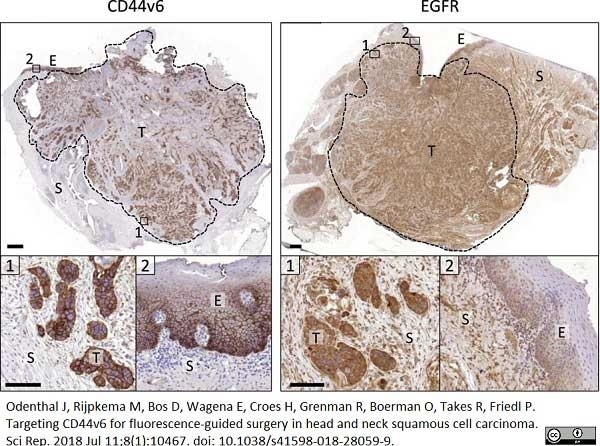CD44v6 antibody | VFF-18

Mouse anti Human CD44v6
- Product Type
- Monoclonal Antibody
- Clone
- VFF-18
- Isotype
- IgG1
- Specificity
- CD44v6
| Mouse anti Human CD44v6, clone VFF-18 recognizes a centrally located 14mer epitope encoded by amino acid residues 18-31, within variant exon 6 (v6) of human CD44 (Reinisch et al, 1998). CD44 is a member of a polymorphic family of transmembrane glycoproteins, which exists as a broadly expressed ~80-90 kDa standard form (CD44s), and also as numerous splice variants, due to extensive alternative splicing and post-translational modifications. CD44s is involved in cell adhesion, lymphocyte activation, signal transduction, haematopoiesis, recirculation and homing, and CD44v6 mediates leukocyte to endothelial cell attachment and rolling, as well as homing to sites of inflammation and peripheral organs. As well as its role as a receptor for hyaluronic acid (HA), CD44s also interacts with other ligands including matrix metalloproteinases (MMPs), fibronectin and collagens, and has been linked with cancer of the breast, colon, stomach and squamous cell carcinomas (HNSCC) of the head and neck, as well as being a prognostic marker for non-Hodgkin's lymphoma. The variant isoforms of CD44 (CD44v) are highly expressed on epithelial cells but not leukocytes, and their association with cell transformation and cancer is also well established, supported by numerous immunohistochemical investigations including those looking at HNSCC. Mouse anti Human CD44v6, clone VFF-18 binds to CD44v6 with high affinity when compared with anti-CD44v6 clone 2F10, and is suitable for detecting CD44v6 in inflammatory bowel disease (IBD) (Reinisch et al. 1998). |
- Target Species
- Human
- Product Form
- Purified IgG - liquid
- Preparation
- Purified IgG prepared by affinity chromatography on Protein G from tissue culture supernatant
- Buffer Solution
- Phosphate buffered saline
- Preservative Stabilisers
- <0.1% Sodium Azide (NaN3)
- Immunogen
- Glutathione S Transferase (GST) fusion protein corresponding to the variable domain v6 of human CD44.
- Approx. Protein Concentrations
- IgG concentration 1.0 mg/ml
- Fusion Partners
- Spleen cells from immunized BALB/c mice were fused with cells of the P3X63Ag8.653 myeloma cell line.
- Regulatory
- For research purposes only
- Guarantee
- 12 months from date of despatch
Avoid repeated freezing and thawing as this may denature the antibody. Storage in frost-free freezers is not recommended.
| Application Name | Verified | Min Dilution | Max Dilution |
|---|---|---|---|
| ELISA | |||
| Flow Cytometry | |||
| Immunohistology - Frozen | 1.0 | 2.0ug/ml | |
| Immunohistology - Paraffin 1 | 1.0 | 2.0ug/ml | |
| Western Blotting |
- 1 This product requires antigen retrieval using heat treatment prior to staining of paraffin sections. Tris/EDTA buffer pH 9.0 or Sodium citrate buffer pH 6.0 is recommended for this purpose.
- Flow Cytometry
- Use 10ul of the suggested working dilution to label 1x106 cells in 100ul
| Description | Product Code | Applications | Pack Size | List Price | Your Price | Quantity | |
|---|---|---|---|---|---|---|---|
| Mouse IgG1 Negative Control | MCA928 | F | 100 Tests |
|
Log in | ||
| List Price | Your Price | ||||||
|
|
Log in | ||||||
| Description | Mouse IgG1 Negative Control | ||||||
Source Reference
-
Reinisch, W. et al. (1998) Poor diagnostic value of colonic CD44v6 expression and serum concentrations of its soluble form in the differentiation of ulcerative colitis from Crohn's disease.
Gut. 43 (3): 375-82.
References for CD44v6 antibody
-
Foekens, J.A. et al. (1999) Prognostic value of CD44 variant expression in primary breast cancer.
Int J Cancer. 84 (3): 209-15. -
Odenthal, J. et al. (2018) Targeting CD44v6 for fluorescence-guided surgery in head and neck squamous cell carcinoma.
Sci Rep. 8 (1): 10467.
MCA5950GA
If you cannot find the batch/lot you are looking for please contact our technical support team for assistance.
Please Note: All Products are "FOR RESEARCH PURPOSES ONLY"
View all Anti-Human ProductsAlways be the first to know.
When we launch new products and resources to help you achieve more in the lab.
Yes, sign me up